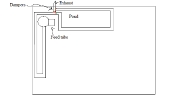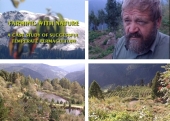


Justin Rhodes 45 minute video tour of wheaton labs basecamp
will be released to subscribers in:
soon!







 3
3




 ) I would go with carp and an out door pond system .
) I would go with carp and an out door pond system .Living in Anjou , France,
For the many not for the few
http://www.permies.com/t/80/31583/projects/Permie-Pennies-France#330873
 3
3









"Never doubt that a small group of thoughtful, committed citizens can change the world; indeed, it's the only thing that ever has."-Margaret Mead "The only thing worse than being blind, is having sight but no vision."-Helen Keller




"People may doubt what you say, but they will believe what you do."
 3
3




No Excuses Suburban Garden
300 total sq. ft. intensively cultivated, hugulkultur beds, producing at over 500lbs or $1500-5k of food annually in Zone 5b.
6 chickens worth of droppings, bedding, and 3 peoples worth of food waste provide plenty of compost to keep the beds growing indefinitely.
$500 up front cost(minus reclaimed materials): includes loam and compost, lumber for building beds and chicken coop, tools, chickens, and fencing for garden and chicken run, rain barrels or buckets
$300 upkeep costs(minus reclaimed supplies): includes seeds, chicken feed, mulch and water.
 4
4




"The highest function of ecology is the understanding of consequences."
"Cultivate gratitude; hand out seed packets"
 6
6




 1
1




Dado




There probably are ways to do it, permaculturally, but I can't come up with a sure fire trick that would work everywhere. There is the heating and then there is the pumping. You might be able to use a compost system to heat your pond system. You might be able to use a solar panel to pump your water. it would depend on your situation. At my place, I would consider maybe a gravity feed system that runs creek water into a large compost system thus heating the water and at the same time dumping the water into a hot tank that cools slightly and drops it into the fish tank, the overflow from the fish pond going into aquatic plant tanks and then outside into other systems. Feeding the fish might not be too big a problem permaculture style: Black Soldier Fly, Compost Worms, meal worms... there are options.
 3
3








Gardens in my mind never need water
Castles in the air never have a wet basement
Well made buildings are fractal -- equally intelligent design at every level of detail.
Bright sparks remind others that they too can dance
What I am looking for is looking for me too!






 2
2




List of Bryant RedHawk's Epic Soil Series Threads We love visitors, that's why we live in a secluded cabin deep in the woods. "Buzzard's Roost (Asnikiye Heca) Farm." Promoting permaculture to save our planet.

 4
4




Chasing that dream and enjoying every minute of it!
(Usually)
 3
3
















 1
1




List of Bryant RedHawk's Epic Soil Series Threads We love visitors, that's why we live in a secluded cabin deep in the woods. "Buzzard's Roost (Asnikiye Heca) Farm." Promoting permaculture to save our planet.
 3
3




 4
4




















Chasing that dream and enjoying every minute of it!
(Usually)
 1
1


















 1
1




I can conceive of a system that, like Sepp's, looks more like aquaculture than aquaponics, but has some characteristics of the latter and could certainly be called aquaponics. Since Aquaponics can be broken down to hydroponics and aquaculture combined, and hydroponics can simply be defined as growing plants in nutrient rich water, there is no reason that aquaponics need be constrained to systems which involve high tech pumps, plastics, or grid electricity, which seem to be things that permaculturalists might want to minimize if they plan to follow the ethics.It occurs to me that most people are responding to the question with the notion that the system will be used in a rural or off grid situation.
However in an urban setting aquaponics would seem to really find it's stride permaculturally. You could recycle/scrap together most of the materials for a home system and commercial systems could make good use of the existing resources (grid power, commercial structures, larger and wealthier market for outputs, etc...) to make a more resilient urban system. For most people on this forum I'd imagine aquaponics in the more technical sense (self contained, recirculating, run by pumps) won't ever hold much appeal beyond a hobby type thing
 Yeah, I know, dream on. But that's just me and the way my brain works. If someone can steer me to thinking that we can create a permanent agricultural system with high tech recirculating aquaponic systems that also care for the Earth then I'd enjoy being enlightened toward that end.
Yeah, I know, dream on. But that's just me and the way my brain works. If someone can steer me to thinking that we can create a permanent agricultural system with high tech recirculating aquaponic systems that also care for the Earth then I'd enjoy being enlightened toward that end.
Freaky neat, actually, in my humble opinion.it has been running continualy uncovered outside for 6 years and the original foam matt has been entirely consumed by a massive root mass that has begun to gather detritus and build soil and there are now earthworms and these gameris shrimp that appeared without human introduction along with a couple other macroarthropods that we haven't identified. Pretty neat.
"Never doubt that a small group of thoughtful, committed citizens can change the world; indeed, it's the only thing that ever has."-Margaret Mead "The only thing worse than being blind, is having sight but no vision."-Helen Keller




Certainly grid power is not going to reduce in price














Maybe.
I suspect that grid power pricing is going to become variable, and you will have programmable devices that go with it.
E.g. when the wind is blowing on a sunny day, and the windmills are spinning fast, power goes down to 3c/kWh. On a cold still winter night it may be 20c/kWh
At 3c/kWh it becomes economical to electrolyze hydrogen from water, and store it, then later burn it in combine cycle MHD/gas turbine to generate power. You lose about half the energy doing this, so power has to down to half the price to make it worth while.
Similarly the generating equipment doesn't get used much, so you have to amortize that out over fewer kWh's So the sales price will tend to be higher. As more devices are made, the gap between times of surplus and times of deficit get smaller.
Even now, at the utility level, companies are putting in industrial sized batteries. (Move with a crane...) At present they are used where by putting in a 100 MWh (megawatt hours) battery they can save rebuilding a powerline. The existing line can cope with the average power demeand, but not the peak.
Battery and remote small plants along with smart monitoring are stabilizing forces on the grid.
"Never doubt that a small group of thoughtful, committed citizens can change the world; indeed, it's the only thing that ever has."-Margaret Mead "The only thing worse than being blind, is having sight but no vision."-Helen Keller
 1
1




 1
1




Canberra Permaculture - My Blog - Wild Cheesemaking - Aquaponics - Korean Natural Farming




Please give me your thoughts on my Affordable, double-paned earthbag window concept





















Bless your Family,
Mike
 1
1




Pearl Sutton wrote:Good topic!! My personal opinion is of the "find local fish" camp.
Still able to dream.

 3
3




Sometimes the answer is nothing





Iterations are fine, we don't have to be perfect
My 2nd Location:Florida HardinessZone:10 AHS:10 GDD:8500 Rainfall:2in/mth winter, 8in/mth summer, Soil:Sand pH8 Flat
 1
1




S Bengi wrote:If you had a fish market that was throwing away fish gut.
Then you would have a 'free' 16lbs of fish to grow 160lbs of herbs+vegetables and 5lbs of fish.
A possible win-win for everyone.
Aquaponic Farms (Fish+Herbs+Vegetables)
Is a wonderful way to make a living, better than how I make my living (environmentally+emotionally)
It takes up alot less footprint.
It uses less pesticides/etc
(Even 'horrible' hydroponic have organic fertilizer, so not all chemicals)
It uses less water
It uses about the same amount of feed as chicken/egg farming
It does however uses pumps aka energy aka fossil fuel.
But the pump energy could be 'green' (hydro/wind/solar) with grid tie for storage/backup.
There is AT type software+senor packages out their to automate some of so that nature does the 'hard' work will you go on a 7day vacation, alot better than with a goat/cow/pig.
"People get out your way, when you're on fire". Richard Prior




Whatever it takes to dodge a time clock.
 1
1




Jason Hernandez wrote:
Pearl Sutton wrote:Good topic!! My personal opinion is of the "find local fish" camp.
Definitely. Did you know that the Mozambique tilapia is notorious as one of the world's worst invasive fishes? When I saw a pair in the Magante river in my community, I thought, "Oh,no, there goes the ecosystem." But then Hurricanes Irma and Maria came through, the river was a raging torrent, and I have not seen that pair since -- or any other tilapias. If I was going to raise fish in my area, I would probably go with dajao, i.e. mountain mullet, since those are the most common native fish in the river, and I have seen them up to ten inches long, where the water body is large enough.




Canberra Permaculture - My Blog - Wild Cheesemaking - Aquaponics - Korean Natural Farming

|
Yeah, but does being a ninja come with a dental plan? And what about this tiny ad?
The new permaculture playing cards kickstarter is now live!
https://www.kickstarter.com/projects/paulwheaton/garden-cards
|







